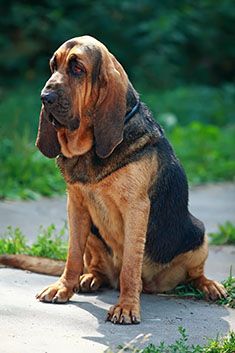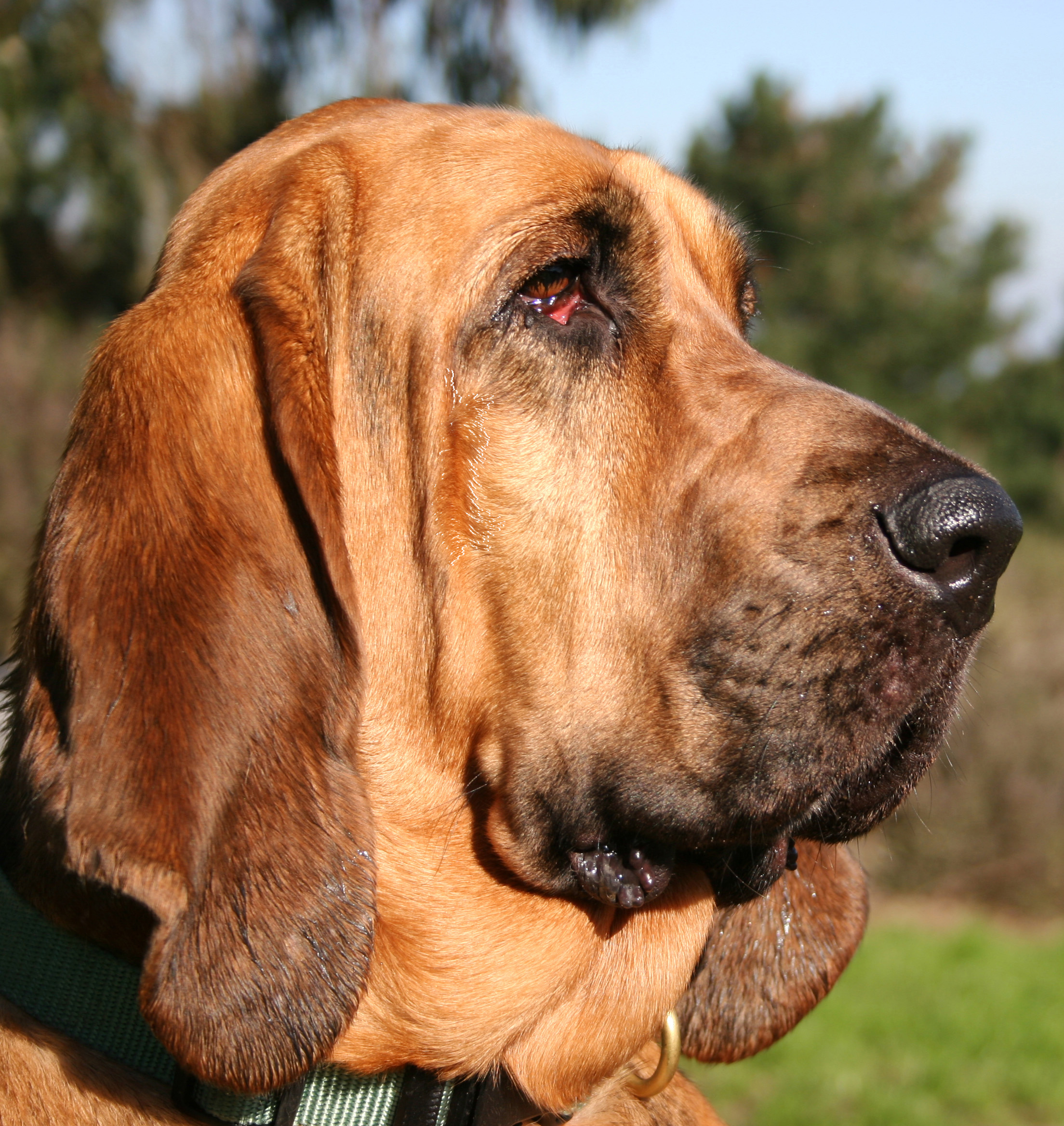
The Breed History
This breed was renowned as far back as the third century in
writings for the ability to track exceptionally well. Characteristically,
they were noted for following even a very faint scent until
the target or quarry was reached. Thought to originate around the
Mediterranean, they were taken to Europe long before the crusades.
The black strain was called St. Hubert's, after the Belgian monastery
where they were extensively bred in the seventh century, and the
white strain was called the Southern, or Talbot hound. By the 1600s
this latter strain had died out as a distinct breed. In England, the
black strain derivatives were carefully bred in monasteries and by
royalty, earning them the nick name "blooded hound"; inferring an
aristocratic bloodline of the dog.
Breeding for Function
Bred to follow scent of deer and other large game, their tracking
stamina continues to be highly prized. These, the largest of the
scent hounds are unlike other military and police dogs; these
placid dogs do not attack quarry so their specific working focus
is restricted to just trailing. These most famous scent hounds
are particularly adept at long distance tracks (one recorded track
was 138 miles, 221 km). They are noted for determination and
perseverance. Today, they are famous for search and rescue.
Physical Characteristics
Height at Withers: female 23-25" (58.5-63.5 cm), male 25-27"
(63.5-68.5 cm).
Weight: females 80-100 lb (36-45 kg), males 90-110 lb (41-50 kg).
Coat: Black and tan, liver and tan, and red are accepted coat colors.
Small white areas are permitted on feet, tail tip and chest. Sometimes
the above coat colors are flecked with white. Hair is softer textured
on the ears, otherwise it is a smooth, short and hard coat.
Longevity: 10-12 years.
Points of Conformation: The facial wrinkles and drooping eyes
give the dog a somewhat characteristic expression. Their head
is long, tapers only slightly and is narrow. The breed standard
stipulates a head length of 12" (29.5 cm) or more in males, and
11" (28 cm) or more in females. Their head and neck area is replete
with extensive skin folds. The Bloodhound possesses a prominent
occipital protuberance, eyes are deep and eyelids droop; the weight
of the flews everts the lower lids. Eye colors match the coat, with
hazel and yellow being common pigmentation. Ears are very low
set, long and pendulous, but the leather is fairly fine textured. The
flews are extensive and merged with neck folds, forming the large
dewlap. Body skin is loose. The neck is long, the thorax is rounded
and deep, and the loin is mildly arched. The tail is large, long
and tapered and carried high. Gait is smooth and elastic on this
muscular dog. Legs are straight and solid. Feet are compact and
well knuckled.
Recognized Behavior Issues and Traits
Reported breed characteristics include: Docile, placid, well mannered
and sometimes shy. They are friendly both with other dogs and
with people. They love children and are very patient even with
active toddlers. They can be a challenge to obedience train due to a
tendency for independent thinking. Young dogs are very boisterous,
but though they continue to be high activity dogs outdoors, they
are low activity dogs around the home. Puppies are curious, and are
known for eating inappropriate objects. They drool, and they may
snore. Bloodhounds are not known for alarm barking, but may howl,
bay, whine and sing. Provide a well-bedded sleep area to help prevent
hygromas. Bloodhounds should not be allowed off leash because
they will wander after scents. If bored, they can dig or jump their
fences. May tend to pull on leash, so early training is important.
Normal Physiologic Variations
Slow to mature.
Drug Sensitivities
None reported
Inherited Diseases
Hip Dysplasia: Polygenically inherited trait causing degenerative
joint disease and hip arthritis. OFA reports 26.1% affected.
Elbow Dysplasia: Polygenically inherited trait causing elbow
arthritis. OFA reports 15.4% affected.
Patella Luxation: Polygenically inherited laxity of patellar ligaments,
causing luxation, lameness, and later degenerative joint disease.
Treat surgically if causing clinical signs. OFA reports 3.4% affected.
Disease Predispositions
Ectropion: Rolling out of eyelids, often with a medial canthal
pocket. Can also cause conjunctivitis. Can be secondary to
macroblepharon; an abnormally large eyelid opening. Dorn reports
a 7.97x odds ratio in Bloodhounds versus other breeds. Ectropion is
reported in 30.63% of Bloodhounds CERF examined by veterinary
ophthalmologists between 2000-2005.
Entropion: Rolling in of eyelids, often causing corneal irritation or
ulceration. Dorn reports a 7.97x odds ratio in Bloodhounds versus
other breeds. Entropion is reported in 26.25% of Bloodhounds CERF
examined by veterinary ophthalmologists between 2000-2005.
Retinal Dysplasia: Retinal folds, geographic, and generalized retinal
dysplasia with detachment are recognized in the breed. Reported in
8.75% of Bloodhounds CERF examined by veterinary ophthalmologists
between 2000-2005.
Gastric Dilation/Volvulus (GDV, Bloat): Life-threatening twisting
of the stomach within the abdomen. Requires immediate veterinary
attention. Glickman found 8.7% of Bloodhounds developed GDV.
Dorn reports an 14.32x odds ratio for GDV versus other breeds.
Hypothyroidism: Inherited autoimmune thyroiditis. 7.7% positive
for thyroid auto-antibodies based on testing at Michigan State
University. (Ave. for all breeds is 7.5%).
Cataracts: Anterior cortex intermediate cataracts predominate,
though posterior, nuclear, and capsular cataracts also occur in
the breed. Identified in 6.89% of Bloodhounds CERF examined by
veterinary ophthalmologists between 2000-2005. CERF does not
recommend breeding any Bloodhound with a cataract.
Persistent Pupillary Membranes: Strands of fetal remnant
connecting; iris to iris, cornea, lens, or involving sheets of tissue. The
later three forms can impair vision, and dogs affected with these
forms should not be bred. Identified in 5.00% of Bloodhounds CERF
examined by veterinary ophthalmologists between 2000-2005, with
4.38% involving iris to cornea.
Prolapsed Gland of the Nictitans (Cherry Eye): This condition
occurs secondary to inflammation of the gland. Reported in 1.88%
of Bloodhounds CERF examined by veterinary ophthalmologists
between 2000-2005.
Chronic Superficial Keratitis (Pannus): Inflammation of the cornea,
causing vision problems due to corneal pigmentation. Age of onset
2-5 years. Treatment with topical ocular lubricants and anti-inflammatory
medication. Identified in 1.88% of Bloodhounds CERF
examined by veterinary ophthalmologists between 2000-2005.
Ventricular Septal Defect (VSD): Congenital opening in the
interventricular wall causing communication between the left and
right ventricles. Often causes a systolic murmur without clinical
signs, but can cause tachypnea or exercise intolerance. Reported at
a 37x Odds Ratio versus other breeds.
Degenerative Myelopathy (DM): Rare disorder in the breed.
Affected dogs show an insidious onset of upper motor neuron
(UMN) paraparesis. The disease eventually progresses to severe
tetraparesis. Affected dogs have normal results on myelography,
MRI, and CSF analysis. Necropsy confirms the condition. Unknown
mode of inheritance. A direct genetic test for an autosomal
recessive DM susceptibility gene is available. All affected dogs are
homozygous for the gene, however only a small percentage of
homozygous dogs develop DM. OFA reports DM susceptibility gene
frequencies of 39% carrier, and 6% homozygous "at-risk".
Brachygnathism, Cryptorchidism, Keratoconjunctivitis Sicca, and
Spinal Muscular Atrophy are reported.
Isolated Case Studies
Multiple Congenital Eye Anomalies: Two unrelated Bloodhound
puppies were examined for congenital blindness, with
microphthalmia, goniodysplasia, cataracts, lenticonus with rupture
of the lens capsule, persistent pupillary membranes, persistent
hyperplastic tunica vasculosa lentis and persistent hyperplastic
primary vitreous (PHTEL/PHPV), and retinal dysplasia.
Persistent Hyperplastic Tunica Vasculosa Lentis/Persistent
Hyperplastic Primary Vitreous (PHTVL/PHPV): Case study of a 4
month-old Bloodhound. Presented with posterior polar subcapsular
cataracts and pre-retinal glial proliferation.
Genetic Tests
Tests of Genotype: Direct test for a DM susceptability gene is
available from the OFA.
Tests of Phenotype: CHIC Certification: Required testing includes
hip and elbow radiographs, and cardiac evaluation (recommended
by a specialist). Recommended tests include CERF eye examination,
patella and PennHIP evaluation. (See CHIC website; www.
caninehealthinfo.org).
Recommend thyroid profile including autoantibodies.
Miscellaneous
- Breed name synonyms: St. Hubert Hound, St. Hubert's Hound,
Chien de St. Hubert, Flemish hound.
- Registries: AKC, UKC, CKC, KCGB (Kennel Club of Great Britain),
ANKC (Australian National Kennel Club), NKC (National Kennel Club).
- AKC rank (year 2008): 43 (3,203 dogs registered)
- Internet resources: The American Bloodhound Club:
www.bloodhounds.org
Canadian Bloodhound Club: www.canadianbloodhoundclub.com
The United Kingdom Bloodhound Club:
www.bloodhoundclub.co.uk
Photo Gallery of Breed - Bloodhound - Dog Breed








 Animalia Life
Animalia Life